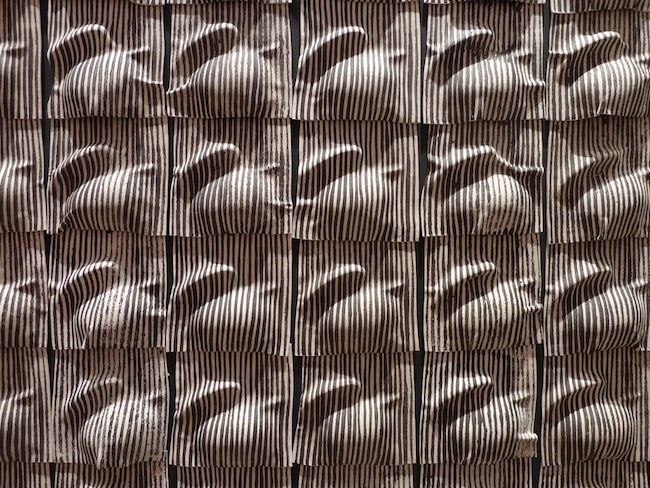In the previous post on Ian Johnston’s ceramic installations Garth Clark wrote: “If you do not know the installation art of Johnston that is a loss. If one were to compile a list of the top practitioners of this genre in ceramics, he would need to be near the top. At the same time you can be forgiven for this omission because Johnston has not shown much outside Canada.”
Johnston’s three-part installation Reinventing Consumption is at the Robert McLaughlin Gallery in Oshawa, Ontario after a three year tour of venues in Canada. Joanne Marion, curator of Esplanade Art Gallery, explains the concept:
“The first section, The Inventor’s Room, presents artifacts related to his original experiments and investigations into a vacuum-forming process for ceramics. The Antechamber is a repeating-motif ceramic environment crated through this process, which evokes the massive scale of consumer goods manufacturing today. And finally, The Chamber is an inflating and deflating piece which shrouds and reveals an enormous mass of household items diverted from the waste stream in Medicine Hat.
“Johnston comments that although his invention of the vacuum forming process for ceramics is unique, his actual intention in developing it was simply to see what would happen, to open up new opportunities for his art practice. And after seeing 12 year-old Alistair Aiken’s game Inv-Ento-Opoly, he realized that his purpose had shifted to the idea of invention itself. Through the invention process, there are always surprises and unexpected results, and for Johnston, this proved to be the possibility of radically adapting the ceramic vacuum forming process to create The Chamber.“
In a review of the exhibition in Alternatives Journal (May 2, 2014) Eric Nay writes:
“Johnston’s inventive method of ceramic production draws from industrial design as well as traditional ceramics. His ceramic reliefs are formed by draping wet clay over discarded industrial objects, covering the clay in plastic and then using the suction from a classic Electrolux canister vacuum cleaner to remove enough air to create a moulded relief panel. The process can be replicated over and over again; in this particular installation Johnston created enough sculptural panels to cover not just a single wall, but to form an entire room in the gallery.
“Johnston’s process yields beautifully formed sculptural reliefs, each rich with shade, shadow and texture, and equally rich in meaning. Sustainability appears as a subtext on numerous levels, and is particularly evident in his material choices and methods of fabrication, which depend upon post-consumer waste. Each of his panels is precisely crafted, and when joined in an array, form a post-industrial tapestry of consumer waste. The negative forms of discarded typewriters, rotary telephones and incandescent light bulbs appear as the material evidence of designed obsolescence in Johnston’s sculptural reliefs. This obsolescence, the rise of postwar consumer culture and today’s rising sea of e-waste are all strong thematic components in Johnston’s work.
“Some of the worst and most overlooked byproducts of our culture of designed objects arise from the fabrication process itself, but Johnston’s process is purposely transparent: videos revealing each step of his process and the tools of his craft are part of the installation. We may have abandoned many of the lessons and materials that have informed traditional design over the centuries, but Johnston has revived the conversation about material traditions, methods of fabrication and sustainability through his work.
“[The artist] seems to be breathing some new life back into clay, the ur-material of man’s origins, if you believe in such golemic stuff. Plastic, clay and vacuum cleaners may represent an ideal material palette for making sustainable art in the twenty-first century. As Gregory Beatty pointed out in his article, “Some Thoughts on Stuff,” in Regina’s alternative local newspaper, Prairie Dog, ‘Clay has long been Johnston’s preferred medium. But it has extra resonance in Reinventing Consumption because in addition to being an art medium the material has a strong utilitarian tradition in craft and production pottery.'”
The impact of this stunning and beautifully composed exhibition is, as Marion states:
“… a critique, both ironic and earnest, of our human obsession with glamorizing and inflating the unimportant, along his exploration of invention and development of remarkable forms from mundane origins. Mesmerizing, intriguing and sobering, Reinventing Consumption brings home to viewers, as Johnston comments, ‘the paradoxical relationship between limited resources and seemingly unlimited appetite.’”
The exhibition is accompanied by an excellent paperback catalog Ian Johnston: Reinventing Consumption by Kimberly Philips and Ihor Holubizky (Robert McLaughlin Gallery, Oshawa, Canada 56 pages).
Bill Rodgers is a Contributing Editor at CFile.
Above image: From Ian Johnston’s Reinventing Consumption.
Any thoughts about this post? Share yours in the comment box below.
Ian Johnston, The Chamber, at Langham Cultural Centre.
An outdoor video of same.
An interview with Ian Johnston.
Ian Johnston discussing Reinventing Consumption.





Ian Johnston, Reinventing Consumption, The Antechamber, installation views and closeups.




Ian Johnston, Reinventing Consumption, The Inventor’s Room, installation views and closeups.

Ian Johnston, Reinventing Consumption, The Chamber, closeup. See video to experience the The Chamber in action.

Ian Johnston in The Antechamber.

Catalog of Reinventing Consumption by Kimberly Philips and Ihor Holubizky.
Visit Robert McLaughlin Gallery
Read CFile’s writeup of Ian Johnston’s Refuse Culture

SOOOOO cool to see Paddy and Art Fag city covering an amazing artist from back home ( the interior of British Columbia, Canada!!!) while here in N.Y.
Ian has been a power house presence in the almost none-existent art scene I grew up in( I was the intern at the tiny gallery in Vernon when he showed there!) Now I’m here in NY (not successful in anyway shape or form, but I’m here) and to see him on Art Fag City is absolutely awesome!!